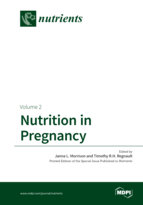Nutrition in Pregnancy
A special issue of Nutrients (ISSN 2072-6643).
Deadline for manuscript submissions: closed (31 October 2014) | Viewed by 306711
Special Issue Editors
Interests: fetus; early life nutrition; HypoxiA; intrauterine growth restriction; cardiovascular development; cardiovascular disease; maternal obesity; neonatal; programming; DOHaD
Interests: placental and fetal development and function, origins of adult metabolic disease; NCDs, animal/human models; PET/CT; MRI; hypoxia; oxidative stress; maternal diet
Special Issues, Collections and Topics in MDPI journals
Special Issue Information
Dear Colleagues,
Maternal nutrition during pregnancy is of considerable interest to women, their partners and their health care professionals; however, it is a complex issue. In developing countries, maternal undernutrition is a major concern. However, with the increased prevalence of overweight and obesity in developed countries, the impact of abundant high calorie diet upon pregnancy outcome is of interest. In addition to the amount of nutrition available and its macronutrient composition within a diet, there is emerging evidence highlighting important roles for the lesser studied micronutrients. Added to this complexity is the distinction between maternal and fetal nutrition and the impact the placenta plays in nutrient metabolism and overall nutrient supply to the fetus. Together, these many variables contribute to fetal growth, and where fetal nutrition and growth is comprised, through poor maternal diet, and or diet induced alterations in placental metabolism. These deviations from the expected growth trajectory can have lifelong effects on individuals. This issue aims to highlight research in each of these areas.
Dr. Janna Morrison
Guest Editor
Manuscript Submission Information
Manuscripts should be submitted online at www.mdpi.com by registering and logging in to this website. Once you are registered, click here to go to the submission form. Manuscripts can be submitted until the deadline. All submissions that pass pre-check are peer-reviewed. Accepted papers will be published continuously in the journal (as soon as accepted) and will be listed together on the special issue website. Research articles, review articles as well as short communications are invited. For planned papers, a title and short abstract (about 100 words) can be sent to the Editorial Office for announcement on this website.
Submitted manuscripts should not have been published previously, nor be under consideration for publication elsewhere (except conference proceedings papers). All manuscripts are thoroughly refereed through a single-blind peer-review process. A guide for authors and other relevant information for submission of manuscripts is available on the Instructions for Authors page. Nutrients is an international peer-reviewed open access semimonthly journal published by MDPI.
Please visit the Instructions for Authors page before submitting a manuscript. The Article Processing Charge (APC) for publication in this open access journal is 2900 CHF (Swiss Francs). Submitted papers should be well formatted and use good English. Authors may use MDPI's English editing service prior to publication or during author revisions.
Keywords
- fetal growth
- postnatal health
- growth trajectory
- maternal diet
- macronutrients
- micronutrient
- intrauterine growth restriction
- placenta
- uterine blood flow








